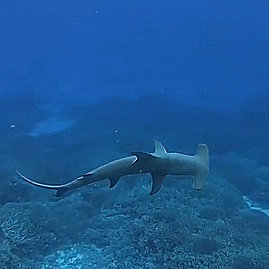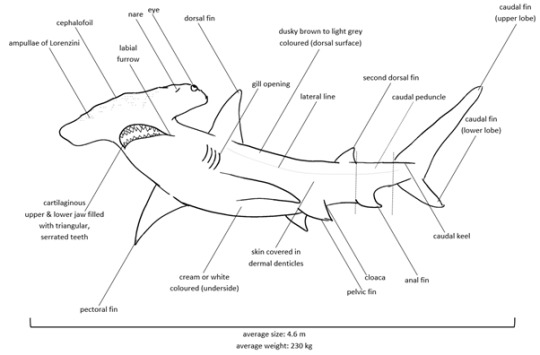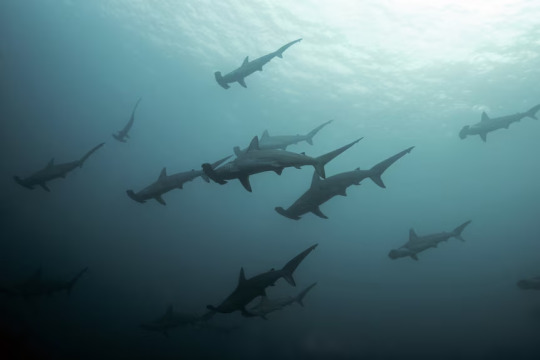Text
Magnificent Nature: The Hammerhead

Okay, You’re A Shark Conservationist…..
There’s a question I get asked so many times when I bring up what I do for a living, and it seems like it’s always the same thing. “Why does a hammerhead's head look like a hammer, and what is it used for?”
Well, I'm going to do more than just write a research paper on it, that's for sure. I’m going to tell you everything about this fantastic shark species, and why they’re my favorite out of all sharks in the ocean.

The Visible Truth
10 times out of 10 you can spot which shark is a hammerhead, and it all comes down to its name, as well as the simple fact that this shark does indeed have a head like a hammer. So, what is it used for, and how can this oddly shaped head lead to a shark’s survival?

The Head
The head of a hammerhead shark is called a cephalofoil, this helps provide lift making it easier and more efficient to move instead of swimming upright like other predators. This ‘cephalofoil’ or head, helps the shark make quick turns and pin their food to the seafloor. However, this behavior isn’t documented through the lens of a camera.
Unlike most sharks who have their eyes facing forward, a hammerhead’s eyes are widely separated, connecting to the cephalofoil at the sides. This drastic change in appearance, makes the hammerhead have a wider view of the sea rather than its relatives, who only see at a certain angle. In total a hammerhead shark can see 360 degrees around its body, like a panoramic camera. However, these creatures cannot see in-front of them.

They can sense what?!
This hammer head also contains electroreceptor pores, called Ampullae of Lorenzini. These pores help sense electrical waves in the ocean, and make it easier to hunt down and locate prey. It should also be known that the hammerhead has the most electroreceptor pores than any other shark, and these are just in it’s head!
These electroreceptor pores are extremely sensitive and can detect as small as 5 billionths volt per square centimeter. Which is why when humans tend to swim in the ocean, and splash around, sharks can be spotted. A single splash from a single person at the beach can reach a hammerhead’s pores in less than 3 minutes.
A splash to us, is just a splash. However, a splash to a shark means a struggling fish, leading to possible attacks or encounters.

How do they Hunt, though?
A hammerhead’s head can help this creature roll over and swim sideways, to save energy for big hunts. How amazing is that? When hunting these species of shark typically hunt alone, and can be found in temperate or tropical waters all around the world.
These sharks are very social creatures, they form a school of hundreds of hammerheads at a time, but by dawn (which is typically when a hammerhead hunts) they go their separate ways until it is time to have a nice family gathering.
Hammerhead’s can communicate with each other by simply moving their bodies in a certain way, whether that means a change in weather, prey scouting, or migration. Their prey includes a variety of fish such as; bony fish, crustaceans, batoids, and mollusks. However their preferred prey are animals such as; stingrays, octopus and lobsters.

Migration and Mating
Some populations of hammerheads move pole-ward during the winter, however females tend to migrate offshore earlier than males, and return to the same sites to pup (give birth) once they reach maturity.
These magnificent females can give birth to up to 50 pups all at once, and their pregnancy typically lasts for 8 to 10 months. Some of this species can even give “virgin births’.

Final Thoughts
I love talking about this species, as they are the most sought out for their fins. And in my personal opinion, one of the most cool looking sharks in the open ocean as of today. (Slightly beating the goblin shark.)
I hope you learned something, and as always RESPECT THE LOCALS!
#cute sharks#i love sharks#lemon sharks#marine#marine animal#marine biology#marine life#save the sharks#shark speaks#sharks#hammerhead shark#marine biodiversity#sea creatures#ocean#oceancore#waves#sea#water#coast#shore#paradise#tropical#Hawaii
36 notes
·
View notes
Text
How Do Seasons Affect Sharks?

The Real Question
There is a question that I've been dying to know the answer to, so I brought out my pens and paper to answer this brain grabbing question. However, the real question is how I managed to research this and draw a conclusion. (With multiple resources.)
So, how do seasons truly affect marine life, but more specifically, how do different seasons affect a shark’s ability to hunt, track down prey, and function normally.
Links:
Nicole The Great White Shark
Cold blooded sharks
Shark Nursery

Winter
Just like many of us, winter causes sharks to slow down, and become sluggish creatures. Just like if our hands get too cold they might feel numb, and it’s hard to get them warm again. This is just how shark’s feel since (most) of these magnificent creatures are cold blooded.
Sharks cannot regulate their body temperature, so their body temperature mirrors that of its surrounding waters. However, in order to survive and breathe more efficiently, sharks tend to migrate to warmer waters, where food is plentiful, and the water; full of oxygen.
Some sharks like the Salmon Shark have developed a mechanism that allows them to maintain a slightly higher body temperature then the surrounding water; which allows them to live in waters you typically wouldn’t find a Great White or a Hammerhead.
So what exactly happens in winter that makes sharks decide they need to migrate?
Well, due to cold waters sharks may experience decreased muscle function, impaired vision, difficulty swimming and breathing.
Some sharks like The Great White need to be able to move to pump water through their lungs. This is called Obligate Ram Ventilation, where the shark swims with its mouth open allowing water to run through its gills, in order to breathe and survive.
While sounding unimportant, winter is an extremely vital season for marine life. This spike in cold temperatures allows them to migrate, causing new food opportunities, and hey; who doesn’t like to travel?

Spring
Ah yes, spring. A symbol of rebirth and a new era. This can be said for the ocean as well. As the waters heat up, days become longer, and more nutrients surface from the depths, Spring is a time of renewal and getting back to the norm in the ocean.
Sharks are still migrating in spring, much less that of any season, like the famous "Nicole" who swam from South Africa to Australia and back again, covering a total of approximately 12,400 miles in under nine months. Sharks are just traveling creatures, there’s no slowing them down.
Spring also indicates the beginning of mating season, which can lead to many shark sightings on coastlines. As spring begins the increase of plankton skyrocket, bringing in other fish which are a plentiful food source for sharks.
While spring is vitally important for the ocean and its ecosystem, summer is where the ocean truly thrives.

Summer
Just like in spring, the water temperature spikes, causing sharks to once again migrate, however, this time to cooler waters. Warmer waters speed up a shark’s metabolism, meaning they eat more frequently to maintain proper energy levels.
During this hot season, sharks typically will follow their prey to new locations. This may cause some shark species like the Hammerhead or Tiger shark to move closer to the shoreline, leading to shark sightings and potential attacks.
This season is especially beneficial for the younger, smaller sharks. Summer provides an environment for young sharks to grow protecting themselves from bigger, much larger sharks. These are called shark nurseries.
While every season is vitally important for sharks, summer truly takes the number one spot for activity.

Fall
Once again, as the waters start to cool down sharks migrate to warmer waters. These guys just don’t stop moving, do they? However, the impact of fall varies from shark species. While tiger and bull sharks are known to thrive in low oxygenated waters, a black tip cannot survive in waters with low oxygen concentrate.
During this time, shark mating season comes to a halt and female sharks begin hunting to support the new life inside their growing belly.

Conclusion
Just like humans, sharks have their preferences, in order to know exactly how a certain season affects a shark, you would first need to pick out a specific species. Not one shark is like the other, just like you and me. Therefore, no specific season fits every single shark in the sea.
I hope you learned something from this, because I sure did!
#cute sharks#i love sharks#lemon sharks#marine#marine animal#marine biology#marine life#save the sharks#shark speaks#sharks#ocean#seasons#season#great white shark#hammerhead shark#whale shark#respect the locals#conservation#shark conservation
6 notes
·
View notes
Text
"There's A Giant Shark In The Bermuda Triangle"

The 2003 Bermuda Shark Mystery
Many of you might not have known about this baffling event that left Australian shark scientists puzzled for over 2 decades, and yes; it’s as weird as it gets. Mainly, due to the location.
Oh yeah, this story takes place in the Bermuda Triangle, daunting right?
Back in 2003 scientists who were working on the first large shark tagging research project, off the coast of Australia tagged a great white which they named “Shark Alpha.”
Which sounds pretty cool, not going to lie, but her case was absolutely groundbreaking, and wasn’t the last for this Bermuda Mystery.
In September 2003, Dave Riggs and his wife were on board helping CSIRO, (Australia’s Government Scientific Research Organization), tag sharks to gain a better understanding of the behavior of different shark species in Australia.
Numerous shark species were tagged in this event, however before too long each shark was displaying behaviors you normally wouldn’t find in those particular species.
Shark “Alpha”

To begin this fantastic shark’s tale, it’s important I write this fairly clear. Shark Alpha was no way, shape or form small, ranging in at 2 meters or 6 feet, she was at the prime of her adolescent life.
Her behaviors stayed normal after receiving the tag, seeming like she was doing just fine.
However, on Christmas Eve 2003, data from the tag indicated she had descended at rapid speeds off the continental shelf, all the way to 580 meters. (1902.89 feet!!) Within seconds, her temperature reading on the tag, indicated a massive spike, going from 46 degrees, to 78 degrees, that’s an increase of 32 degrees in only a blink of an eye!
Scientists could only think at all the possibilities, but down 580 meters, there was no way for her temperature to sky rocket so fast, and more the less, be at a higher temp. The only explanation these researchers could fathom was Shark Alpha had been consumed and now their tag was in the stomach of a living animal.
The tag popped up only 2 1\2 miles from where the scientists originally tagged shark Alpha.
Rule Out The Likely Cause

Many researchers thought to themselves about what could have happened, maybe an Orca attacked the shark, or perhaps a giant whale for that matter. These theories seem to sound good, but with not enough scientific backing, there was no valid points, but at this point, researchers were doing all they could to figure out this mystery.
Okay, but Those Orca’s Are Weird…
Yes, while we all admit that wearing a salmon’s head on your head is a pretty inhumane way to live, we cannot rule out this possibility of an Orca being responsible. Most of you are probably thinking, “It had to be an Orca, there’s no other way.’ Orcas have been known to hunt and feed on great whites in the past, what could have happened?
Back in 2003, we had no evidence yet to prove that orcas do feed on great white sharks, and it was just discovered no older than 3 years ago. However, Orcas don’t take a massive bite out of the center of the shark, they usually grab the shark’s fin and pull, tearing the shark at the liver. Orcas do consume shark liver as it is fattier and a much bigger reward than a seal.
Ranging in with a bite force of 19,000 pounds per square inch (psi), the Orca or Killer whale, has the strongest bite force of any animal in the animal kingdom. (As we know.) While a great white shark’s bite force is 4,000 psi. So, this sounded like a deal breaker to the scientists, but in order to accurately dispute or prove their claim, many scientists turned to orca specialist to learn more about this magnificent but weird species.
Before the science team could begin their digging on orca research, the body of a great white shark had been beached, with a clean bite mark, essentially; this shark had been bitten in half by something unknown.
While looking at an Orca now, they do have an insanely high bite force, yet, their teeth aren’t designed for biting clean giant chunks, their ragged teeth are designed for ripping and tearing. Hence, not matching up with the great white shark’s fatal wounds.
The Blue Whale Theory

Looking at this from an outsider’s perspective, I surely didn’t understand why these scientists were pointing their fingers at a blue whale. Sure, they’re giant and have many teeth, however blue whales are just not carnivorous creatures. They eat plankton despite their huge size, but their teeth are in no way capable of biting a great white in half.
Another valid point was made by these researchers. The depth these magnificent creatures can reach is up to 1,033 ft (315 m) or more, but tend to typically feed at depths of less than 328 ft (100 m).
Meaning, blue whales typically and usually do not go as far as (580m), or the depth at which shark alpha was attacked and consumed.
What Is Eating All These Sharks?
Scientists now think that the thing consuming and biting these sea mammals in half, are none other then: Sharks themselves.
Is there a massive shark in the Bermuda triangle? With no other leads, and at the time research was not as advanced as it is today. Making this team of researchers draw on one conclusion; “There’s A Giant Shark In The Bermuda Triangle”
#i love sharks#cute sharks#lemon sharks#marine animal#marine biology#marine#save the sharks#shark speaks#sharks#marine life#orca#orca whale#research#bermuda#bermuda triangle#interesting#blue whale
3 notes
·
View notes